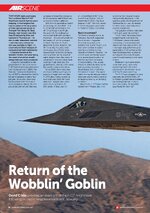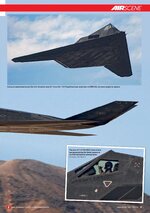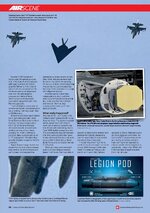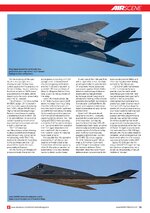MIflyer
1st Lieutenant
For the last 30+ years, Don Kirlin has been flying for the airlines, working on real estate deals, setting up the world's biggest skydiving meets, and building a private air force the likes of which even he has a hard time believing is possible. In March 2020, The War Zone was among the first to report that his company would be purchasing multiple squadrons worth of surplus Royal Australian Air Force (RAAF) F/A-18 Hornets to be used in the contractor adversary air support role here in the United States. In that role, they would primarily fly against U.S. military fighter pilots, replicating aerial threats from potential enemy nations. So basically, they are bad guys for hire, but strictly for training and development work.
Now, not only do we have all the details on that purchase, which is even more impressive than it initially seemed, but we talked at length with the entrepreneur owner of Air USA, located in Quincy, Illinois, about his company's past and what is turning into a remarkable, if not downright historic, future.
Don Kirlin imported his first foreign military jet, and L-39 Albatross, in 1994, at a time when doing so was an extremely complex and convoluted affair full of pitfalls and unknowns. Since then, he has repeated the process dozens of times over and was the first owner of a private MiG-29 Fulcrum in the United States, among a long list of other exotic flying firsts. He now holds eight licenses with the Bureau of Alcohol Tobacco and Firearms (ATF), allowing him to own military machine guns and cannons, as well as thousands of rounds of ammunition to fire through them.
Don Kirlin with members of his Air USA team., Air USA
He was also one of the early pioneers of the then-fledgling, if not wholly experimental, adversary air support market. In the early 2000s, he joined forces with the Airborne Tactical Advantage Company (ATAC), which was blazing a trail with their contracts with the Navy to supply fast jet targets and electronic warfare pod toting adversaries that mimic everything from enemy cruise missiles to fighters for Navy and Marine fighter aircraft and Navy surface combatants to train against.
During those early years, Air USA worked as a subcontractor for ATAC, flying the vast majority of the contracted subsonic adversary support flight hours. So, Kirlin and his company's experience in what is now an exploding adversary support marketplace dates back to its very genesis.
Prior to the Hornet purchase, Kirlin's most outlandish import was not just one, but four MiG-29 Fulcrums. He was the first private owner of one of these jets in the United States. , Air USA
Fast forward to 2020 and Kirlin now owns an impressive fleet of ex-military aircraft that perform a wide number of roles for the Defense Department, from training Joint Terminal Attack Controllers (JTACs), the modern designation for Forward Air Controllers on the ground, to saturating the sensor systems of America's most advanced tactical fighters with aggressor adversaries in the air. With the individual contracts that will underpin the Air Force's gargantuan adversary air support tender about to doled out, Air USA's operation has to grow in capacity and complexity in order to even attempt to meet demand.
Enter the most spectacular private aircraft purchase of all time—Air USA's acquisition of all of the Royal Australian Air Force's remaining F/A-18A/B Hornets. Canada had bought 25 prior to this deal going through. The jets Air USA is slated to receive, 46 in total, of which 36 are flying today, will be replaced by the F-35A Joint Strike Fighter within the RAAF's ranks and thus will be totally retired from service by the end of 2021.
Aussie F/A-18A/B Hornets and their replacements, F-35As. , © Commonwealth of Australia, Department of Defence
Although the terms of the deal have not been disclosed [at the time this was written in 2020], the purchase does include all of the RAAF's F/A-18 spare parts inventory and test equipment, valued at over a billion dollars alone, according to Kirlin. Those parts will be incredibly valuable as Air USA is planning on putting every single airframe it receives back into service—not just the 36 aircraft that are flyable today, but the other 10 that are not, as well.
Those jets just need inspections and are not parted out or grounded for any other reasons. This will allow Air USA to operate at least three fully outfitted squadrons of the 4th generation fighters at all times, which Kirlin hopes will be forward deployed to key bases around the United States where they will primarily help give fleet pilots, testers, and tactics developers, a run for their money in the air-to-air combat arena.

© Commonwealth of Australia, Department of Defence
These are not Hornets in some dated configuration, either. The RAAF spent a lot of money keeping its legacy Hornet fleet relevant until replacements arrived. One of the most important capabilities the jets come with is the bolt-on Elta EL-L/8222 (license-built in the U.S. under the L3Harris Advanced Capability Pod name) electronic warfare pod. These Israeli-designed pods are pretty much the world standard in modular self-protection jamming systems and are used on the Pentagon's own aggressor fleet, as well as by various nations around the globe on frontline aircraft. You can learn just how powerful this system is, being able to turn even highly antiquated aircraft into formidable and deadly aerial threats, especially when paired with unique tactics, in this past piece of ours.
All of Air USA's secondhand Hornets feature the AN/APG-73 radar—the same one that is found on the F/A-18C/D and early F/A-18E/F Super Hornets—that differs from the less capable AN/APG-65 radar the A/B Hornet was originally equipped with. The AN/APG-73 remains a very capable radar set and is largely superior to anything else on the adversary market at this time. Kirlin also informs us that the radar and electronic warfare pod are integrated in such a way that the aircraft can simultaneously jam and engage (jam and shoot) enemy targets, which he doesn't believe exists anywhere else on the adversary market and is a critical capability when it comes to mimicking more advanced foreign fighter threats.
AN/APG-73 Radar in the nose of an F/A-18 Hornet. , Raytheon
The jets also come with their Northrop Grumman AN/AAQ-28 LITENING advanced targeting pods, which are hugely capable in the air-to-ground targeting and non-traditional reconnaissance realm, as well as for positively identifying aircraft visually at long ranges. You can read all about this function and its value in this past piece of ours. In addition, the Hornets come with 68 Joint Helmet Mounted Cueing Systems (JHMCS), which offers helmet-mounted display capability that drastically increases a pilot's situational awareness and high-off-boresight targeting for close-range air-to-air missiles. This will make it easier for these aggressor jets to simulate foreign capabilities of a similar nature.
Overall, Kirlin informs us that that the Aussie Hornets are being imported in exactly the same configuration as they are flying operationally today the RAAF. Nothing is being removed, even the jet's Link 16 data-link system and its internal M61 20mm Vulcan cannon are staying put.


Now, not only do we have all the details on that purchase, which is even more impressive than it initially seemed, but we talked at length with the entrepreneur owner of Air USA, located in Quincy, Illinois, about his company's past and what is turning into a remarkable, if not downright historic, future.
Don Kirlin imported his first foreign military jet, and L-39 Albatross, in 1994, at a time when doing so was an extremely complex and convoluted affair full of pitfalls and unknowns. Since then, he has repeated the process dozens of times over and was the first owner of a private MiG-29 Fulcrum in the United States, among a long list of other exotic flying firsts. He now holds eight licenses with the Bureau of Alcohol Tobacco and Firearms (ATF), allowing him to own military machine guns and cannons, as well as thousands of rounds of ammunition to fire through them.
Don Kirlin with members of his Air USA team., Air USA
He was also one of the early pioneers of the then-fledgling, if not wholly experimental, adversary air support market. In the early 2000s, he joined forces with the Airborne Tactical Advantage Company (ATAC), which was blazing a trail with their contracts with the Navy to supply fast jet targets and electronic warfare pod toting adversaries that mimic everything from enemy cruise missiles to fighters for Navy and Marine fighter aircraft and Navy surface combatants to train against.
During those early years, Air USA worked as a subcontractor for ATAC, flying the vast majority of the contracted subsonic adversary support flight hours. So, Kirlin and his company's experience in what is now an exploding adversary support marketplace dates back to its very genesis.
Prior to the Hornet purchase, Kirlin's most outlandish import was not just one, but four MiG-29 Fulcrums. He was the first private owner of one of these jets in the United States. , Air USA
Fast forward to 2020 and Kirlin now owns an impressive fleet of ex-military aircraft that perform a wide number of roles for the Defense Department, from training Joint Terminal Attack Controllers (JTACs), the modern designation for Forward Air Controllers on the ground, to saturating the sensor systems of America's most advanced tactical fighters with aggressor adversaries in the air. With the individual contracts that will underpin the Air Force's gargantuan adversary air support tender about to doled out, Air USA's operation has to grow in capacity and complexity in order to even attempt to meet demand.
Enter the most spectacular private aircraft purchase of all time—Air USA's acquisition of all of the Royal Australian Air Force's remaining F/A-18A/B Hornets. Canada had bought 25 prior to this deal going through. The jets Air USA is slated to receive, 46 in total, of which 36 are flying today, will be replaced by the F-35A Joint Strike Fighter within the RAAF's ranks and thus will be totally retired from service by the end of 2021.
Aussie F/A-18A/B Hornets and their replacements, F-35As. , © Commonwealth of Australia, Department of Defence
Although the terms of the deal have not been disclosed [at the time this was written in 2020], the purchase does include all of the RAAF's F/A-18 spare parts inventory and test equipment, valued at over a billion dollars alone, according to Kirlin. Those parts will be incredibly valuable as Air USA is planning on putting every single airframe it receives back into service—not just the 36 aircraft that are flyable today, but the other 10 that are not, as well.
Those jets just need inspections and are not parted out or grounded for any other reasons. This will allow Air USA to operate at least three fully outfitted squadrons of the 4th generation fighters at all times, which Kirlin hopes will be forward deployed to key bases around the United States where they will primarily help give fleet pilots, testers, and tactics developers, a run for their money in the air-to-air combat arena.
© Commonwealth of Australia, Department of Defence
These are not Hornets in some dated configuration, either. The RAAF spent a lot of money keeping its legacy Hornet fleet relevant until replacements arrived. One of the most important capabilities the jets come with is the bolt-on Elta EL-L/8222 (license-built in the U.S. under the L3Harris Advanced Capability Pod name) electronic warfare pod. These Israeli-designed pods are pretty much the world standard in modular self-protection jamming systems and are used on the Pentagon's own aggressor fleet, as well as by various nations around the globe on frontline aircraft. You can learn just how powerful this system is, being able to turn even highly antiquated aircraft into formidable and deadly aerial threats, especially when paired with unique tactics, in this past piece of ours.
All of Air USA's secondhand Hornets feature the AN/APG-73 radar—the same one that is found on the F/A-18C/D and early F/A-18E/F Super Hornets—that differs from the less capable AN/APG-65 radar the A/B Hornet was originally equipped with. The AN/APG-73 remains a very capable radar set and is largely superior to anything else on the adversary market at this time. Kirlin also informs us that the radar and electronic warfare pod are integrated in such a way that the aircraft can simultaneously jam and engage (jam and shoot) enemy targets, which he doesn't believe exists anywhere else on the adversary market and is a critical capability when it comes to mimicking more advanced foreign fighter threats.
AN/APG-73 Radar in the nose of an F/A-18 Hornet. , Raytheon
The jets also come with their Northrop Grumman AN/AAQ-28 LITENING advanced targeting pods, which are hugely capable in the air-to-ground targeting and non-traditional reconnaissance realm, as well as for positively identifying aircraft visually at long ranges. You can read all about this function and its value in this past piece of ours. In addition, the Hornets come with 68 Joint Helmet Mounted Cueing Systems (JHMCS), which offers helmet-mounted display capability that drastically increases a pilot's situational awareness and high-off-boresight targeting for close-range air-to-air missiles. This will make it easier for these aggressor jets to simulate foreign capabilities of a similar nature.
Overall, Kirlin informs us that that the Aussie Hornets are being imported in exactly the same configuration as they are flying operationally today the RAAF. Nothing is being removed, even the jet's Link 16 data-link system and its internal M61 20mm Vulcan cannon are staying put.




